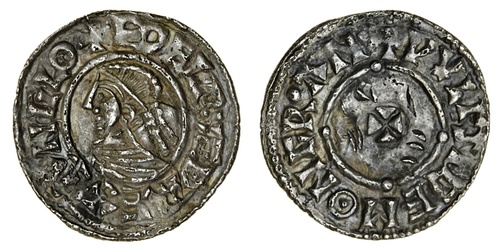
Auction: 19006 - British, Indian and Islamic Coins: Autumn Auction
Lot: 181
Aethelred II (978-1016), Penny, Last Small Cross type, Cambridge, Wulfsige, 1.28g, 12h,
SJA 12, 5 November 2009, lot 368
Lockett I, Glendining, 6-9 June 1955, lot 657 [part] ~ illustrated on pl. XVI (657a)
In Jacobs' study of the Cambridge mint for the 1984 Seaby Bulletin, he documented the following: "The last small cross type concludes the issues of Aethelred II and in this type the names of seven moneyers are recorded, but the coins of only two of them - Aelfwig [21 coins] and Wulfsige [31 coins] - are the only ones which have survived in any quantity, and of these, the coins of Aelfwig are mainly in Scandinavia. Of the other moneyers, in all only 13 coins are recorded (Cnit [1]; Clern [4]; Eadric [1]; Leofhun [1]; Leofsige [6]). This issue provides an interesting feature in a sequence of dies used by Wulfsige or, at least, in his name. One obverse die is found coupled with five different reverse dies (and possibly a sixth), and three of the reverse dies exhibit pellets of variable number and position. From the Anglo-Saxon Chronicle, it is learnt that Cambridge was sacked and burnt by the Danes in 1010, within the period when the last small cross type coins were in issue. Could it have been during the upheaval of the burning of the town and the confusion which followed, that a shortage of dies was experienced, and that the dies in the name of Wulfsige were marked with pellets so they could be used by other moneyers and their coins denoted, and all coupled with this available obverse die?"
For further reading, see:
K A Jacobs, ‘The Mint of Cambridge: Part I”, Seaby Bulletin, February 1984, pp. 34-43
H A Parsons, 'Symbols and Double Names on Late Saxon Coins', BNJ XIII, 1917, pp. 1-74
Subject to 20% VAT on Buyer’s Premium. For more information please view Terms and Conditions for Buyers.
Sold for
£350
Starting price
£210




